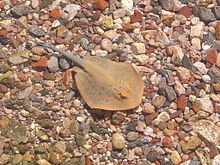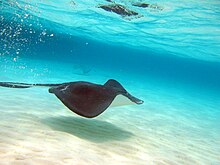This is an old revision of this page, as edited by Bantosh (talk | contribs) at 18:18, 5 September 2006 (revert). The present address (URL) is a permanent link to this revision, which may differ significantly from the current revision.
Revision as of 18:18, 5 September 2006 by Bantosh (talk | contribs) (revert)(diff) ← Previous revision | Latest revision (diff) | Newer revision → (diff) For other uses, see Stingray (disambiguation).
| Stingrays | |
|---|---|

| |
| Bluespotted ribbontail ray, Taeniura lymma | |
| Scientific classification | |
| Kingdom: | Animalia |
| Phylum: | Chordata |
| Class: | Chondrichthyes |
| Order: | Rajiformes |
| Family: | Dasyatidae |
| Genera | |
|
Dasyatis | |
Dasyatidae is a family of rays, cartilaginous marine fishes.
Dasyatids are common in tropical coastal waters throughout the world, and there are fresh water species in Asia (Himantura sp.), Africa, and Florida (Dasyatis sabina). Most dasyatids are neither threatened nor endangered. The species of the genera Potamotrygon, Paratrygon, and Plesiotrygon are all endemic to the freshwaters of South America.
Dasyatids swim with a "flying" motion, propelled by motion of their large pectoral wings (commonly mistaken as "fins").
Their stinger is a razor-sharp, barbed or serrated cartilaginous spine which grows from the ray's whip-like tail (like a fingernail). It is coated with a toxic venom. This gives them their common name of stingrays, but that name can also be used to refer to any poisonous ray.
Like other rays, dasyatids are viviparous (bearing live young in "litters" of 5–10).
Feeding habits

Since their eyes are on top of their body, and their mouths on the bottom, stingrays cannot see their prey. Instead, they use the sense of smell and electro-receptors similar to those of the shark. They feed primarily on molluscs and crustaceans or occasionally on small fish, and their mouths contain powerful, shell-crushing teeth. Rays settle on the bottom while feeding, sometimes leaving only the eyes and tail visible.
Aggression
Dasyatids generally do not attack aggressively, or even actively defend themselves. When threatened, their primary reaction is to swim away. However, when they are attacked by predators or stepped on, the barbed stinger in their tail is mechanically whipped up. This attack is normally ineffective against their main predator: sharks. Humans are usually stung in the foot; it is also possible, although less likely, to be stung by brushing against the stinger. Contact with the stinger causes local trauma (from the cut itself), pain and swelling from the venom, and possible infection from parts of the stinger left in the wound. Injuries to humans include, but are not limited to: poisoning, punctures, severed arteries and possible death. Fatal stings, such as that which killed Australian naturalist and television personality Steve Irwin in 2006, are extremely rare. As of 1996, worldwide known deaths from stingray barb injuries numbered 17. As of 2001 there has been only one person documented to have survived a stingray injury to the heart.
Treatment for stings includes hot water (as hot as the victim can stand), which helps ease pain and break down the venom, and antibiotics. Other possible pain remedies include papain (papaya extract, contained in unseasoned powdered meat tenderizer), which may break down the protein of the toxins, though this may be more appropriate for jellyfish and similar stings. Folklore incorrectly holds that one should urinate on the stung area; in actuality, urine and vinegar are not effective treatments. Pain normally lasts up to 48 hours but is most severe in the first 30 – 60 minutes and may be accompanied by nausea, fatigue, headaches, fever and chills.

As food
Rays may be caught on a fishing line using small crabs as bait, and are often caught accidentally; they may also be speared from above. They are edible; small rays may be cooked similarly to other fish, typically grilled or battered and fried. Whilst not independently valuable, the stingray's capacity to damage shellfishing grounds can lead to bounties placed on their removal.
Stingray recipes abound throughout the world, with dried forms of the wings being most common. Generally, the most prized parts of the stingray are the wings, the "cheek" (the area surrounding the eyes,) and the liver. The rest of the ray is considered too rubbery to have any culinary uses.
Viewing
Stingrays are usually very docile creatures. The customary reaction of the stingray is to immediately flee the vicinity where a disturbance is located. Nevertheless, certain larger species are located in waters where they are easily excitable due to possible attacks from feeding sharks and should be approached with caution, as the stingray's defensive reflex and effort to flee may result in human contact with the stinger, resulting in serious injury or even, as noted above, fatality.
Dasyatids are not normally visible to swimmers, but divers and snorkelers may find them in shallow sandy waters, more so when the water is unseasonably warm.
In the Cayman Islands, there are several dive sites called Stingray City, Grand Cayman where divers and snorkelers can swim with large southern stingrays (Dasyatis americana) and feed them by hand.
There is also a "Stingray City" in the sea surrounding the Caribbean island of Antigua. It consists of a large, shallow reserve where the rays live and snorkelling is possible, as the rays there are said to be very friendly.
Most major aquariums feature stingrays, including the national Baltimore Aquarium. The Atlantis Paradise Island Hotel houses many eagle rays, sting rays, and one manta ray. The rays are often coexhibited with other marine life, such as the Caribbean reef shark. The Georgia Aquarium allows petting of southern stingrays in their Georgia Explorer exhibit. Similarly, visitors may use two fingers at a time to touch rays (with sting removed) and related guitarfish in outdoor exhibits at the Aquarium of the Pacific in Long Beach, California. Petting Stingrays is also permitted in a special tank at the Blue Planet Aquarium, Ellesmere Port, UK. Likewise, the Mote Marine Aquarium in Sarasota, Florida allows visitors to pet a variety of rays in a controlled tank setting. Coral World Marine Park in St. Thomas, USVI even allows supervised feeding of southern stingrays by visitors.
In 2006, the Tampa Bay Devil Rays added a 35 foot, 10000 gallon, touch tank in their stadium where fans get a chance to interact with dozens of rays.
Small rays and other fishes can be petted in a "tactile tank" at Nausicaä, a large aquarium park in Boulogne-sur-Mer, on the English Channel coast in northern France. One ray has been known to be so friendly it tried to expose its entire ventral surface, ending up toppling over backward.

Species
There are about seventy species in six genera:
- Genus Dasyatis
- Dasyatis acutirostra Nishida & Nakaya, 1988.
- Red stingray, Dasyatis akajei (Müller & Henle, 1841).
- Southern stingray, Dasyatis americana Hildebrand & Schroeder, 1928.
- Plain maskray, Dasyatis annotata Last, 1987.
- Bennett's stingray, Dasyatis bennetti (Müller & Henle, 1841).
- Short-tail stingray or bull ray, Dasyatis brevicaudata (Hutton, 1875).
- Whiptail stingray, Dasyatis brevis (Garman, 1880).
- Roughtail stingray, Dasyatis centroura (Mitchill, 1815).
- Blue stingray, Dasyatis chrysonota (Smith, 1828).
- Diamond stingray, Dasyatis dipterura (Jordan & Gilbert, 1880).
- Estuary stingray, Dasyatis fluviorum Ogilby, 1908.
- Smooth freshwater stingray, Dasyatis garouaensis (Stauch & Blanc, 1962).
- Sharpsnout stingray, Dasyatis geijskesi Boeseman, 1948.
- Giant stumptail stingray, Dasyatis gigantea (Lindberg, 1930).
- Longnose stingray, Dasyatis guttata (Bloch & Schneider, 1801).
- Dasyatis hastata (DeKay, 1842).
- Izu stingray, Dasyatis izuensis Nishida & Nakaya, 1988.
- Bluespotted stingray, Dasyatis kuhlii (Müller & Henle, 1841).
- Yantai stingray, Dasyatis laevigata Chu, 1960.
- Mekong stingray, Dasyatis laosensis Roberts & Karnasuta, 1987.
- Brown stingray, Dasyatis latus (Garman, 1880).
- Painted maskray, Dasyatis leylandi Last, 1987.
- Longtail stingray, Dasyatis longa (Garman, 1880).
- Daisy stingray, Dasyatis margarita (Günther, 1870).
- Pearl stingray, Dasyatis margaritella Compagno & Roberts, 1984.
- Dasyatis marianae Gomes, Rosa & Gadig, 2000.
- Marbled stingray, Dasyatis marmorata (Steindachner, 1892).
- Pitted stingray, Dasyatis matsubarai Miyosi, 1939.
- Smalleye stingray, Dasyatis microps (Annandale, 1908).
- Multispine giant stingray, Dasyatis multispinosa (Tokarev, 1959).
- Blackish stingray, Dasyatis navarrae (Steindachner, 1892).
- Common stingray, Dasyatis pastinaca (Linnaeus, 1758).
- Smalltooth stingray, Dasyatis rudis (Günther, 1870).
- Atlantic stingray, Dasyatis sabina (Lesueur, 1824).
- Bluntnose stingray, Dasyatis say (Lesueur, 1817).
- Chinese stingray, Dasyatis sinensis (Steindachner, 1892).
- Thorntail stingray, Dasyatis thetidis Ogilby, 1899.
- Tortonese's stingray, Dasyatis tortonesei Capapé, 1975.
- Cow stingray, Dasyatis ushiei (Jordan & Hubbs, 1925).
- Pale-edged stingray, Dasyatis zugei (Müller & Henle, 1841).

- Genus Himantura
- Pale-spot whip ray, Himantura alcockii (Annandale, 1909).
- Bleeker's whipray, Himantura bleekeri (Blyth, 1860).
- Freshwater whipray, Himantura chaophraya Monkolprasit & Roberts, 1990.
- Dragon stingray, Himantura draco Compagno & Heemstra, 1984.
- Pink whipray, Himantura fai Jordan & Seale, 1906.
- Ganges stingray, Himantura fluviatilis (Hamilton, 1822).
- Sharpnose stingray, Himantura gerrardi (Gray, 1851).
- Mangrove whipray, Himantura granulata (Macleay, 1883).
- Himantura hortlei Last, Manjaji-Matsumoto & Kailola, 2006.
- Scaly whipray, Himantura imbricata (Bloch & Schneider, 1801).
- Pointed-nose stingray, Himantura jenkinsii (Annandale, 1909).
- Kittipong's stingray, Himantura kittipongi
- Marbled freshwater whip ray, Himantura krempfi (Chabanaud, 1923).
- Blackedge whipray, Himantura marginatus (Blyth, 1860).
- Smalleye whip ray, Himantura microphthalma (Chen, 1948).
- Marbled whipray, Himantura oxyrhyncha (Sauvage, 1878).
- Pacific chupare, Himantura pacifica (Beebe & Tee-Van, 1941).
- Himantura pareh (Bleeker, 1852).
- Round whip ray, Himantura pastinacoides (Bleeker, 1852).
- Chupare stingray, Himantura schmardae (Werner, 1904).
- White-edge freshwater whip ray, Himantura signifer Compagno & Roberts, 1982.
- Black-spotted whipray, Himantura toshi Whitley, 1939.
- Whitenose whip ray, Himantura uarnacoides (Bleeker, 1852).
- Honeycomb stingray, Himantura uarnak (Forsskål, 1775).
- Leopard whipray, Himantura undulata (Bleeker, 1852).
- Dwarf whipray, Himantura walga (Müller & Henle, 1841).
- Genus Pastinachus
- Cowtail stingray, Pastinachus sephen (Forsskål, 1775).
- Pastinachus solocirostris Last, Manjaji & Yearsley, 2005.
- Genus Pteroplatytrygon
- Genus Taeniura
- Round stingray, Taeniura grabata (É. Geoffroy Saint-Hilaire, 1817).
- Bluespotted ribbontail ray, Taeniura lymma (Forsskål, 1775).
- Blotched fantail ray, Taeniura meyeni Müller & Henle, 1841.
- Genus Urogymnus
- Porcupine ray, Urogymnus asperrimus (Bloch & Schneider, 1801).
- Thorny freshwater stingray, Urogymnus ukpam (Smith, 1863).
References
- "Stingray City - About Stingrays". Caribbean Magazine.
- "'Crocodile hunter' Steve Irwin killed by a stingray". The Guardian. September 4, 2006.
{{cite news}}: Check date values in:|date=(help) - Surf Life Saving Australia (September 4, 2006). "Information on Stingrays".
{{cite web}}: Check date values in:|date=(help) - Weiss, Beatrix (2001). "Survivor of a stingray injury to the heart". The Medical journal of Australia. 175 (1): 33–4. PMID 11476200.
{{cite journal}}: Cite has empty unknown parameter:|quotes=(help); Unknown parameter|coauthors=ignored (|author=suggested) (help); Unknown parameter|month=ignored (help) - Stingray Injuries in the Sea of Cortez
- Last, Manjaji-Matsumoto & Kailola (2006). "Himantura hortlei n. sp., a new species of whipray (Myliobatiformes: Dasyatidae) from Irian Jaya, Indonesia" (PDF). Zootaxa. 1239: 19–34.
- Last, Manjaji & Yearsley (2005). "Pastinachus solocirostris sp. nov., a new species of Stingray (Elasmobranchii: Myliobatiformes) from the Indo-Malay Archipelago" (PDF). Zootaxa. 1040: 1–16.
- Froese, Rainer; Pauly, Daniel (eds.). "Family Dasyatidae". FishBase. August 2005 version.
External link
- University of Pennsylvania Health System – Information on stingray poison.